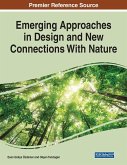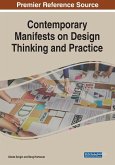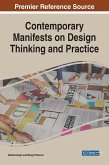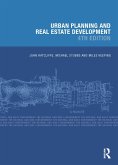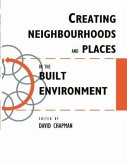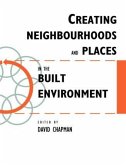Debra Flanders Cushing, Evonne Miller
Creating Great Places
Evidence-based Urban Design for Health and Wellbeing
Debra Flanders Cushing, Evonne Miller
Creating Great Places
Evidence-based Urban Design for Health and Wellbeing
- Gebundenes Buch
- Merkliste
- Auf die Merkliste
- Bewerten Bewerten
- Teilen
- Produkt teilen
- Produkterinnerung
- Produkterinnerung
Creating Great Places is an insightful, compelling, and evidence-based resource for readers who want to design urban environments that inspire, excite, and positively transform people's lives.
Andere Kunden interessierten sich auch für
![Emerging Approaches in Design and New Connections With Nature Emerging Approaches in Design and New Connections With Nature]() Emerging Approaches in Design and New Connections With Nature165,99 €
Emerging Approaches in Design and New Connections With Nature165,99 €![Emerging Approaches in Design and New Connections With Nature Emerging Approaches in Design and New Connections With Nature]() Emerging Approaches in Design and New Connections With Nature214,99 €
Emerging Approaches in Design and New Connections With Nature214,99 €![Contemporary Manifests on Design Thinking and Practice Contemporary Manifests on Design Thinking and Practice]() Contemporary Manifests on Design Thinking and Practice184,99 €
Contemporary Manifests on Design Thinking and Practice184,99 €![Contemporary Manifests on Design Thinking and Practice Contemporary Manifests on Design Thinking and Practice]() Contemporary Manifests on Design Thinking and Practice233,99 €
Contemporary Manifests on Design Thinking and Practice233,99 €![Urban Planning and Real Estate Development Urban Planning and Real Estate Development]() John RatcliffeUrban Planning and Real Estate Development178,99 €
John RatcliffeUrban Planning and Real Estate Development178,99 €![Creating Neighbourhoods and Places in the Built Environment Creating Neighbourhoods and Places in the Built Environment]() David Chapman (ed.)Creating Neighbourhoods and Places in the Built Environment80,99 €
David Chapman (ed.)Creating Neighbourhoods and Places in the Built Environment80,99 €![Creating Neighbourhoods and Places in the Built Environment Creating Neighbourhoods and Places in the Built Environment]() Creating Neighbourhoods and Places in the Built Environment228,99 €
Creating Neighbourhoods and Places in the Built Environment228,99 €-
-
-
Creating Great Places is an insightful, compelling, and evidence-based resource for readers who want to design urban environments that inspire, excite, and positively transform people's lives.
Hinweis: Dieser Artikel kann nur an eine deutsche Lieferadresse ausgeliefert werden.
Hinweis: Dieser Artikel kann nur an eine deutsche Lieferadresse ausgeliefert werden.
Produktdetails
- Produktdetails
- Verlag: Routledge
- Seitenzahl: 214
- Erscheinungstermin: 4. November 2019
- Englisch
- Abmessung: 235mm x 157mm x 16mm
- Gewicht: 468g
- ISBN-13: 9780367257453
- ISBN-10: 0367257459
- Artikelnr.: 58053132
- Herstellerkennzeichnung
- Libri GmbH
- Europaallee 1
- 36244 Bad Hersfeld
- gpsr@libri.de
- Verlag: Routledge
- Seitenzahl: 214
- Erscheinungstermin: 4. November 2019
- Englisch
- Abmessung: 235mm x 157mm x 16mm
- Gewicht: 468g
- ISBN-13: 9780367257453
- ISBN-10: 0367257459
- Artikelnr.: 58053132
- Herstellerkennzeichnung
- Libri GmbH
- Europaallee 1
- 36244 Bad Hersfeld
- gpsr@libri.de
Debra Flanders Cushing is Associate Professor in Landscape Architecture within the School of Design at Queensland University of Technology in Brisbane, Australia. With expertise in landscape architecture and community planning, Debra worked as a design practitioner before focusing on teaching and research in academia. Debra is passionate about promoting evidence-based design within multi-disciplinary initiatives to create parks and urban environments that better support health and wellbeing for all people, especially children and youth. Evonne Miller is Professor and Director of the QUT Design Lab in the School of Design at Queensland University of Technology in Brisbane, Australia. Drawing on her background in environmental gerontology and design psychology, her research focuses on creating sustainable, inclusive and age-friendly places. Evonne has published widely in the fields of urban design, population ageing, climate change and sustainability, and is a passionate advocate for creative arts-based participatory research.
About the Authors
Introduction: Why Evidence-Based Design?
PART I: Six Critical Theories for Contemporary Urban Design
1 Affordance Theory: Take Your Cue
2 Prospect-Refuge Theory: Now You See Me, Now You Don't
3 Personal Space Theory: Keep Your Distance!
4 Sense of Place Theory/Genius Loci: Locating the Magic
5 Place Attachment Theory: Fostering Connections
6 Biophilic Design Theory: The Healing Power of Nature
PART II: Applying Design Theory to Global Priorities 7 Salutogenic Design: Promoting Healthy Living
8 Child-Friendly Design: Where Young People Thrive
9 Age-Friendly and Inclusive Design: Designing for Everyone
10 Sustainable Design: Radically Redesigning Our Built Environment
Conclusion: Creating Great Places through Theory-Storming
Recommended Readings
Acknowledgments
Index
Introduction: Why Evidence-Based Design?
PART I: Six Critical Theories for Contemporary Urban Design
1 Affordance Theory: Take Your Cue
2 Prospect-Refuge Theory: Now You See Me, Now You Don't
3 Personal Space Theory: Keep Your Distance!
4 Sense of Place Theory/Genius Loci: Locating the Magic
5 Place Attachment Theory: Fostering Connections
6 Biophilic Design Theory: The Healing Power of Nature
PART II: Applying Design Theory to Global Priorities 7 Salutogenic Design: Promoting Healthy Living
8 Child-Friendly Design: Where Young People Thrive
9 Age-Friendly and Inclusive Design: Designing for Everyone
10 Sustainable Design: Radically Redesigning Our Built Environment
Conclusion: Creating Great Places through Theory-Storming
Recommended Readings
Acknowledgments
Index
About the Authors; Introduction: Why Evidence-Based Design?; PART I: Six Critical Theories for Contemporary Urban Design; 1 Affordance Theory: Take Your Cue; 2 Prospect-Refuge Theory: Now You See Me, Now You Don't; 3 Personal Space Theory: Keep Your Distance!; 4 Sense of Place Theory/Genius Loci: Locating the Magic; 5 Place Attachment Theory: Fostering Connections; 6 Biophilic Design Theory: The Healing Power of Nature; PART II: Applying Design Theory to Global Priorities 7 Salutogenic Design: Promoting Healthy Living; 8 Child-Friendly Design: Where Young People Thrive; 9 Age-Friendly and Inclusive Design: Designing for Everyone; 10 Sustainable Design: Radically Redesigning Our Built Environment; Conclusion: Creating Great Places through Theory-Storming; Recommended Readings; Acknowledgments; Index
About the Authors
Introduction: Why Evidence-Based Design?
PART I: Six Critical Theories for Contemporary Urban Design
1 Affordance Theory: Take Your Cue
2 Prospect-Refuge Theory: Now You See Me, Now You Don't
3 Personal Space Theory: Keep Your Distance!
4 Sense of Place Theory/Genius Loci: Locating the Magic
5 Place Attachment Theory: Fostering Connections
6 Biophilic Design Theory: The Healing Power of Nature
PART II: Applying Design Theory to Global Priorities 7 Salutogenic Design: Promoting Healthy Living
8 Child-Friendly Design: Where Young People Thrive
9 Age-Friendly and Inclusive Design: Designing for Everyone
10 Sustainable Design: Radically Redesigning Our Built Environment
Conclusion: Creating Great Places through Theory-Storming
Recommended Readings
Acknowledgments
Index
Introduction: Why Evidence-Based Design?
PART I: Six Critical Theories for Contemporary Urban Design
1 Affordance Theory: Take Your Cue
2 Prospect-Refuge Theory: Now You See Me, Now You Don't
3 Personal Space Theory: Keep Your Distance!
4 Sense of Place Theory/Genius Loci: Locating the Magic
5 Place Attachment Theory: Fostering Connections
6 Biophilic Design Theory: The Healing Power of Nature
PART II: Applying Design Theory to Global Priorities 7 Salutogenic Design: Promoting Healthy Living
8 Child-Friendly Design: Where Young People Thrive
9 Age-Friendly and Inclusive Design: Designing for Everyone
10 Sustainable Design: Radically Redesigning Our Built Environment
Conclusion: Creating Great Places through Theory-Storming
Recommended Readings
Acknowledgments
Index
About the Authors; Introduction: Why Evidence-Based Design?; PART I: Six Critical Theories for Contemporary Urban Design; 1 Affordance Theory: Take Your Cue; 2 Prospect-Refuge Theory: Now You See Me, Now You Don't; 3 Personal Space Theory: Keep Your Distance!; 4 Sense of Place Theory/Genius Loci: Locating the Magic; 5 Place Attachment Theory: Fostering Connections; 6 Biophilic Design Theory: The Healing Power of Nature; PART II: Applying Design Theory to Global Priorities 7 Salutogenic Design: Promoting Healthy Living; 8 Child-Friendly Design: Where Young People Thrive; 9 Age-Friendly and Inclusive Design: Designing for Everyone; 10 Sustainable Design: Radically Redesigning Our Built Environment; Conclusion: Creating Great Places through Theory-Storming; Recommended Readings; Acknowledgments; Index



